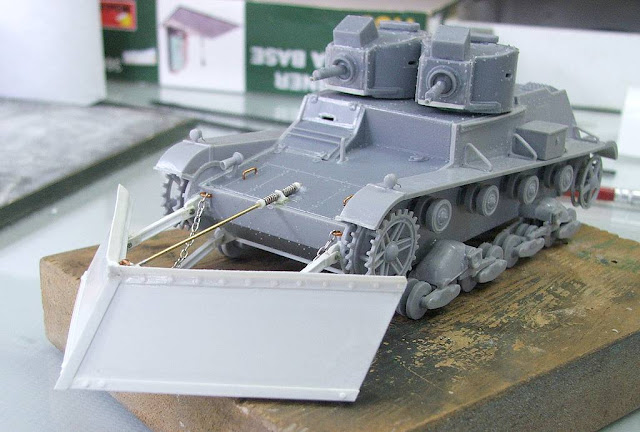Tankers:
This is the building of this interesting and rare model: the 7TP twin turret with snow plow. The project was based in a drawing that I found in the literature. There are no known photos (yet. ..) about this version. |
| 7TP with snow-plow |
The 7TP (siedmiotonowy polski - 7-tonne Polish) was the Polish light tank of the Second World War. A development of the British Vickers 6-ton, it was significantly better armed than its most common opponents, the German Panzer I and Panzer II. A standard tank of the Polish Army during the Polish Defensive War of 1939, its production never exceeded 150 vehicles. Its chassis was used as the base for C7P artillery tractor.
The 7TP was the Polish development of the British Vickers 6-ton Mark E tank licence. Comparing to Vickers, the main new features of 7TP were: a better, more reliable and powerful diesel engine, a 37 mm anti-tank gun, thicker armour (17 mm instead of 13 mm on the front), modified ventilation, the Gundlach tank periscope, and a radio. About 132 tanks were produced between 1935 and the outbreak of the war, plus four iron prototypes. The designation 7TP meant "7 Tonne, Polish" (in fact its weight increased to 9 tonnes after the initial prototype).
The 7TP dw (twin turret):
The abbreviation “dw” stands for “dwuwieżowy” (twin-turret). The design of multi-turret tanks was a trend in the 1930s.
 |
| 7TP dw light tanks in parade 3rd Armoured Battalion - Mokotov Field Warsaw - 1938. |
The armament also followed the standards of the time, with two Browning .30 (7,92mm) machine-guns in each turret. The turrets had 280° traverse and -10° to +20° elevation.
In the tank, the driver stattion was located in the front-right of the hull, the commander and gunner in the turret, with commander in the right and the gunner on the left.
For better vision, each turret had two vision slits with armored glass and telescopic sights. The driver had a front double door hatch, which also comprised a vision slit.
 |
| 7TP dw in the field. Notice the 3 tones cammo and hatch of the driver station |
The dw version were considered a stopgap model, before the more powerful version with single turret could be introduced in the lines. Rearmament tests included a 13.2 mm (0.52 in) Hotchkiss and a 7.92 mm (0.3 in) wz.30, and a total of 16 dw were rearmed according to this new “asymmetric” model.
 |
| 3rd Armoured Battalion - Warsaw - 1938. |
The penetrating power of the heavy machine gun was intended to deal with other light tanks and most armored cars. Later, a few were equipped with radios with mast antennae. They were given to platoons, companies and battalions command tanks.
To see more about the history of this light tank, see here.
Specs:
| 7TP dw | |
|---|---|
| Type | Light tank |
| Place of origin | Poland |
| Service history | |
| Used by | Poland Nazi Germany (captured) |
| Wars | World War II |
| Production history | |
| Produced | 1935-1939 |
| No. built | 149 (+13 9TP prototypes) all types |
| Specifications | |
| Weight | 9.9 tonnes |
| Length | 4.880mm |
| Width | 2.430mm |
| Height | 2.300mm |
| Crew | 3 (commander, gunner, driver) |
| Armor | 17 mm maximum |
Main armament
| 2x .30 (7,92mm) Browning MG |
Secondary armament
| none |
| Engine | PZInż.235(Saurer VBLDd) Liquid-cooled inverted inline 6-cylinder 4-stroke direct injection diesel engine 110 hp (80 kW) |
| Power/weight | 11 hp/tonne |
| Suspension | leaf spring bogie |
| Ground clearance | 0.38 m |
Operational range
| 150 km |
| Speed | 37 km/h |
For this project, I used this kit, from Mirage Hobby (#355002):
...and this profile that I modified from a George Bradford's drawing, to guide me in the Scratch Village!!
 |
| The slits of the turrets are closed... |
 |
| Surgery in progress... |
 |
| Some scratch... |
For building of the blade, I reworked the drawing of book, just extrapolating that to a vision in 3 planes; Done this scheme, print in scale 1/35 and these profiles served as a model for the scratch of my blade ...
 |
| Using the plans... |
 |
| detailing... |
 |
| Making racks and joints |
 |
| Dry-run |
 |
| Building the elevator device |
 |
| Elevator device done... |
Well, painting time...First of all, primer to promote best adherence in the kit. Automotive enamels after the primer, starting with sand-yellow. The camo stripes was made with green and brown. After the paint dries, a fine layer of Future, to prevent the silvering in the decals.
The profile for my little girl:
The profile for my little girl:
 |
| Cammo with green and brown over yellow |
 |
| Weathering with oils and pigments... |
 |
| 7TP dw light tank with snow-plow 3rd Armoured Battalion - Cyeszin Poland - 1938 |
 |
| 7TP dw light tank with snow-plow 3rd Armoured Battalion - Cyeszin Poland - 1938 |
See you soon, in my next project !!!
















